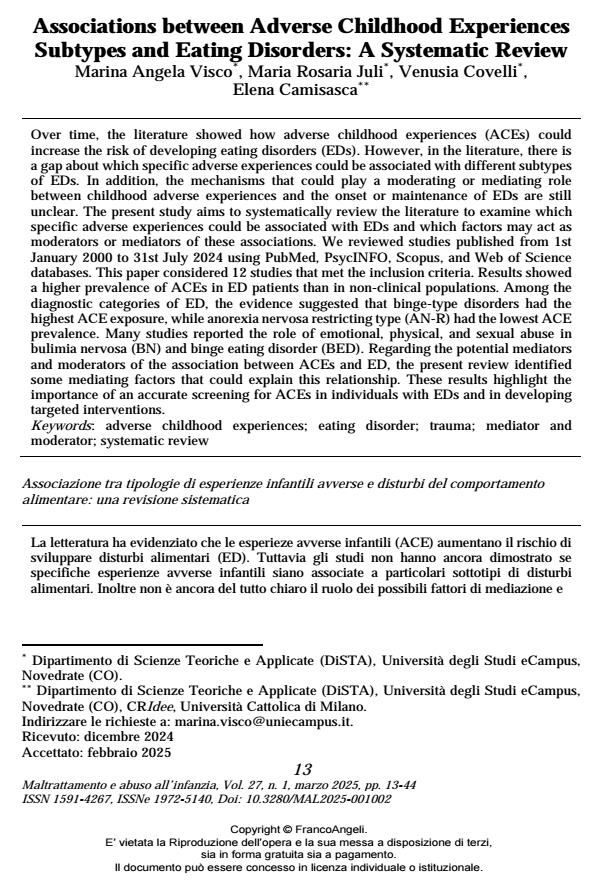Associations between Adverse Childhood Experiences Subtypes and Eating Disorders: A Systematic Review
Journal title MALTRATTAMENTO E ABUSO ALL’INFANZIA
Author/s Marina Angela Visco, Maria Rosaria Juli, Venusia Covelli, Elena Camisasca
Publishing Year 2025 Issue 2025/1
Language English Pages 32 P. 13-44 File size 172 KB
DOI 10.3280/MAL2025-001002
DOI is like a bar code for intellectual property: to have more infomation
click here
Below, you can see the article first page
If you want to buy this article in PDF format, you can do it, following the instructions to buy download credits

FrancoAngeli is member of Publishers International Linking Association, Inc (PILA), a not-for-profit association which run the CrossRef service enabling links to and from online scholarly content.
Over time, the literature showed how adverse childhood experiences (ACEs) could increase the risk of developing eating disorders (EDs). However, in the literature, there is a gap about which specific adverse experiences could be associated with different subtypes of EDs. In addition, the mechanisms that could play a moderating or mediating role between childhood adverse experiences and the onset or maintenance of EDs are still unclear. The present study aims to systematically review the literature to examine which specific adverse experiences could be associated with EDs and which factors may act as moderators or mediators of these associations. We reviewed studies published from 1st January 2000 to 31st July 2024 using PubMed, PsycINFO, Scopus, and Web of Science databases. This paper considered 12 studies that met the inclusion criteria. Results showed a higher prevalence of ACEs in ED patients than in non-clinical populations. Among the diagnostic categories of ED, the evidence suggested that binge-type disorders had the highest ACE exposure, while anorexia nervosa restricting type (AN-R) had the lowest ACE prevalence. Many studies reported the role of emotional, physical, and sexual abuse in bulimia nervosa (BN) and binge eating disorder (BED). Regarding the potential mediators and moderators of the association between ACEs and ED, the present review identified some mediating factors that could explain this relationship. These results highlight the importance of an accurate screening for ACEs in individuals with EDs and in developing targeted interventions.
Keywords: adverse childhood experiences; eating disorder; trauma; mediator and moderator; systematic review
Marina Angela Visco, Maria Rosaria Juli, Venusia Covelli, Elena Camisasca, Associations between Adverse Childhood Experiences Subtypes and Eating Disorders: A Systematic Review in "MALTRATTAMENTO E ABUSO ALL’INFANZIA" 1/2025, pp 13-44, DOI: 10.3280/MAL2025-001002